Florida Diamondback Terrapin
Florida is home to several species of sea turtles, but a less well-known native turtle, the diamondback terrapin (Malaclemys terrapin; Figures 1 and 2), also inhabits Florida’s coastal waters. This lesser-known coastal turtle occurs along Florida’s Atlantic and Gulf coasts; however, many people are unaware of this species. This publication provides information on diamondback terrapin ecology and conservation and will be of interest to lay and professional audiences interested in learning more about this species and contributing to its conservation.
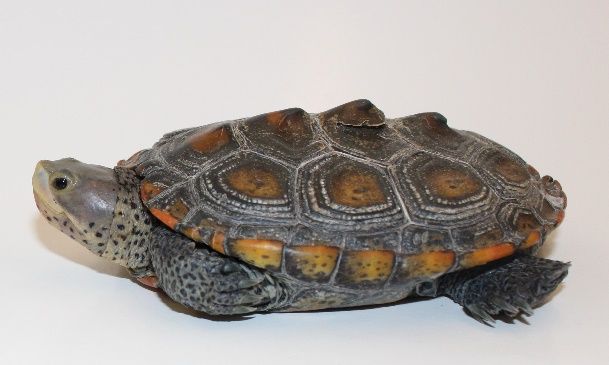
Credit: Travis Thomas, UF/IFAS
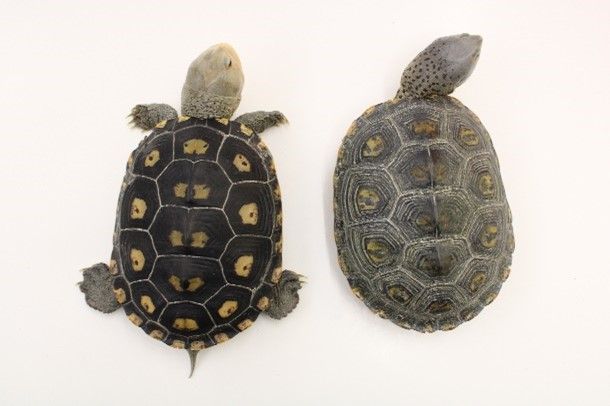
Credit: Travis Thomas, UF/IFAS
The diamondback terrapin (hereafter terrapin) is in the family Emydidae, which includes the familiar “pond and river turtles” (e.g., cooters and sliders). Unlike pond turtles, terrapins have several traits and behaviors that allow them to survive in coastal marine and estuarine environments. Their skin is impermeable to salt, and they have special glands that excrete excess salt. The ability of terrapins to survive in coastal environments is unique among the Emydidae. Also, except for sea turtles (Cheloniidae), terrapins are the only species of turtle that occur in coastal and estuarine environments in North America.
Description
Terrapins are relatively small turtles with a maximum straight-line carapace (top shell) length of around 238 mm (9.4 inches). The females are larger than the males (Butler et al. 2006). Their habitat preferences differentiate them from pond and river turtles, and diamondback terrapins also look different from freshwater pond turtles. Their skin coloration is much lighter with dark markings. The carapace (shell) has ridged, concentric rings on each scute (Figure 3) that are responsible for the common name “diamondback” terrapin. Historically, there have been seven recognized subspecies of diamondback terrapins in the United States, five of which are found in Florida: Carolina (M. t. centrata), Florida east coast (M. t. tequesta), mangrove (M. t. rhizophorarum), ornate (M. t. macrospilota), and Mississippi (M. t. pileata) (Florida Fish and Wildlife Conservation Commission 2024). The division into subspecies was primarily based on physical variations (e.g., skin color patterns, size, etc.), but recent genetic analyses suggest these may not be separate subspecies (Hart et al. 2014).
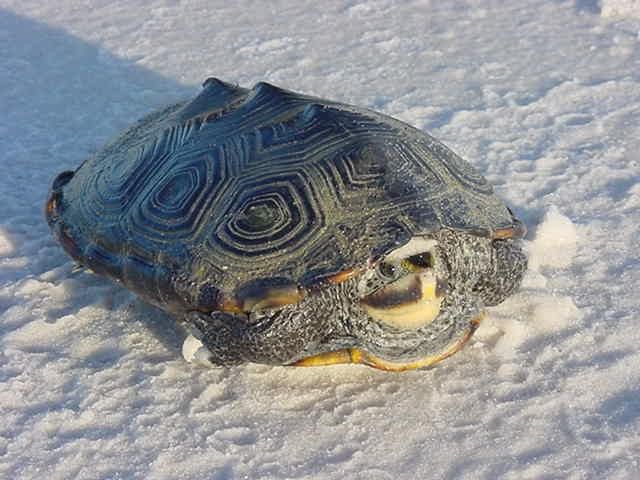
Credit: Andrew Diller, UF/IFAS
Habitat Preference and Special Adaptations
In general, terrapins are understudied compared to other coastal turtle species (i.e., sea turtles), so much of their ecology is poorly understood. However, we do know that in Florida terrapins inhabit a variety of estuarine environments (e.g., tidal creeks, coastal bays, islands, mangroves, saltmarsh, etc.). They are opportunistic feeders but prey heavily on shellfish, particularly mollusks (snails and clams). Terrapins are equipped with adaptations that allow them to exist in the saltwater environment. For example, terrapins’ thick, impermeable skin allows them to store freshwater in their bodies, and they have special glands that secrete excess salt. Terrapins also avoid drinking water with high salinities and instead drink lower salinity water or freshwater on the surface during rainfall events (Butler et al. 2006).
Reproduction
Female terrapins typically reach sexual maturity when their plastron (belly shell) length is near 117 mm (5 inches), which can take from 4–7 years. Males mature at plastron lengths of 90–100 mm (4 inches). They can take 2–7 years to reach maturity (Butler et al. 2006).
In early spring, large numbers of terrapins (groups of up to 75 individuals have been observed) gather in creeks and lagoons within their home marshes. In courtship, males approach females from behind and nudge them to seek acceptance. Terrapins mate at the surface, and the process typically occurs during daylight hours.
In Florida, nesting begins in early April, with females leaving the creeks of the marsh and seeking dry sandy beaches. They usually select beaches with a low slope, a high dry location above spring high tide, and some vegetation. They are known to dig nests along roadsides while seeking these desired dry sandy conditions. Female terrapins sometimes travel a considerable distance to find nesting beaches. In fact, a study found they will travel as far as 10 km (6 miles) (Butler et al. 2006). However, another study found two female terrapins tagged with satellite tags in the western Panhandle of Florida traveled over 48 km (30 miles), but it was not known whether they were searching for nesting sites or not (Lamont et al. 2021). Typically, nesting occurs during sunny, daylight hours, but this varies with location. Along coasts with strong tides, terrapins prefer to nest close to high tide. Female terrapins are known to “sniff” the sand for a suitable location. When they find a satisfactory spot, they begin to dig with their forelimbs. They finish the nest with their hind limbs, producing a cavity about 150 mm (6 inches) deep in which they lay 4–22 eggs (Butler et al. 2006). Females typically lay 2–3 clutches (groups of eggs) each season with clutch sizes ranging from 5–10 eggs (Florida Fish and Wildlife Conservation Commission 2024).
In Florida, the incubation period averages 69 days (range: 55–97; Butler et al. 2006). Incubation time decreases with increasing air temperatures. Hatching usually begins in late June or July and the young can remain in the nest for up to a week before they emerge. Young hatching late in the season may remain in the nest cavity until the following spring (Figure 4), a process called “overwintering.”
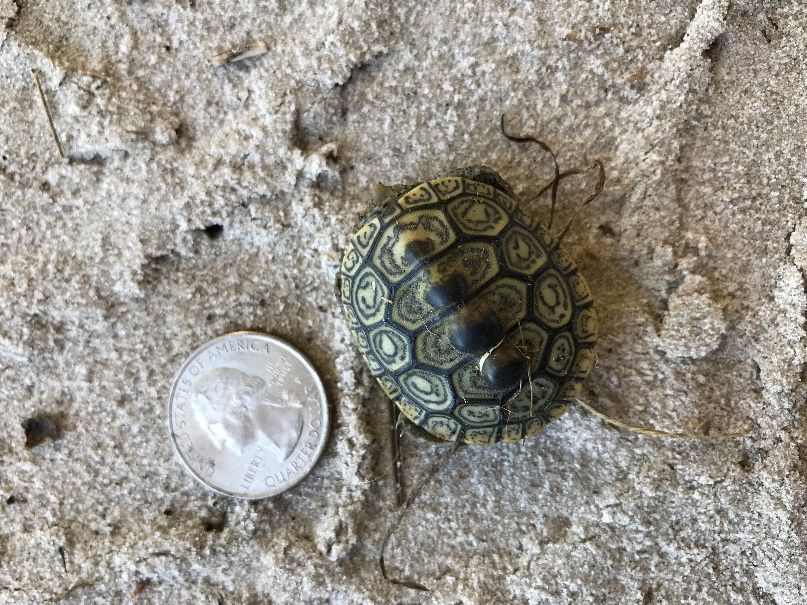
Credit: Travis Thomas, UF/IFAS
As is the case with many other turtle species, sex of the offspring is determined by the temperature within the nest. Nest temperatures between 24°C–27°C (75°F–81°F) tend to produce males, while those between 30°C–32°C (86°F–90°F) produced females. Intermediate temperatures 28°C–29°C (82°F–84°F) may produce either sex (Butler et al. 2006).
After they emerge from their nests, hatchlings seek mats of vegetation on the beach in which to hide from predators. This behavior differs from that of sea turtles, which head for the ocean and swim for open water and sargassum seaweed in which to hide. One study released terrapin hatchlings in open water only to have them return to the beach to find mats of vegetation for hiding cover (Butler et al. 2006).
The primary cause of mortality in diamondback terrapins is nest predators. In many studies, 80% of all nests were depredated. Common nest predators include foxes, otters, crows, skunks, and raccoons.
Threats and Conservation
The terrapin has declined throughout its range due to several factors, including harvest for food and the pet trade, accidental capture (bycatch) in crab traps, habitat loss, and road mortality (Butler et al. 2006). To address these conservation concerns, the Florida Fish and Wildlife Conservation Commission (FWC) approved new regulations concerning Florida terrapins. First, as of March 1, 2022, terrapins may not be bought or sold, and no one may possess a terrapin without a permit from the FWC. Second, as of March 1, 2023, all recreational crab traps in the state must either have a bycatch reduction device that is no larger than 2x6 inches attached to the funnel of the crab trap or a fixed funnel smaller than 2x6 inches, both of which are designed to block terrapins from entering the crab trap (Figure 5). Additional information regarding the conservation status of this secretive turtle is needed. Although Florida ranks the species as secure, some individual populations may be at risk. The state ranks the mangrove terrapin population as imperiled, and research continues to determine the status of other populations in Florida.
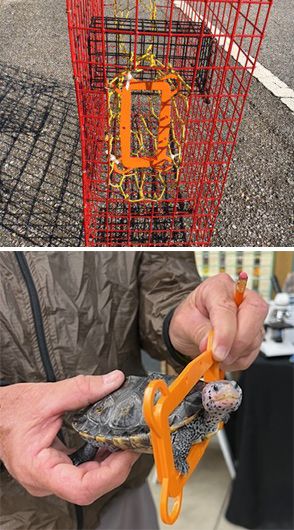
Credit: Rick O’Connor, UF/IFAS Extension Florida Sea Grant
References
Butler, J. A., R. A. Seigel, and B. K. Mealey. 2006. “Malaclemys terrapin – Diamondback Terrapin.” In Biology and Conservation of Florida Turtles, Chelonian Research Monographs No.3, edited by P. A. Meylan. pp. 279–296.
Florida Fish and Wildlife Conservation Commission. Diamondback Terrapin (Malaclemys terrapin). Accessed 2024. https://myfwc.com/wildlifehabitats/profiles/reptiles/freshwater-turtles/diamondback-terrapin/
Ernst, C. H., and J. E. Lovich. 2009. Turtles of the United States and Canada. 2nd ed. Baltimore: Johns Hopkins University Press.
Hart, K. M., M. E. Hunter, and T. L. King. 2014. “Regional Differentiation among Populations of the Diamondback Terrapin (Malaclemys terrapin).” Conservation Genetics 15:593–603.
Lamont, M. M., D. Johnson, and D. J. Catizone. 2021. “Home Ranges and Movements of Two Diamondback Terrapins (Malaclemys terrapin macrospilota) in Northwest Florida.” Estuaries and Coasts 44:1484–1491. https://doi.org/10.1007/s12237-020-00892-0.
Florida Fish and Wildlife Conservation Commission. 2022. “New Rules for Diamondback Terrapins.” https://myfwc.com/wildlifehabitats/wildlife/freshwater-turtles/dbt-rules/
Florida Natural Areas Inventory. 2022. 2022 Element Tracking Summary. https://www.fnai.org/PDFs/tracking/element_tracking_summary_202201.pdf
Roosenburg, W. M., P. J. Baker, R. Burke, M. E. Dorcas, and R. C. Wood. 2019. Malaclemys terrapin. The IUCN Red List of Threatened Species 2019: e.T12695A507698. https://doi.org/10.2305/IUCN.UK.2019-1.RLTS.T12695A507698.en